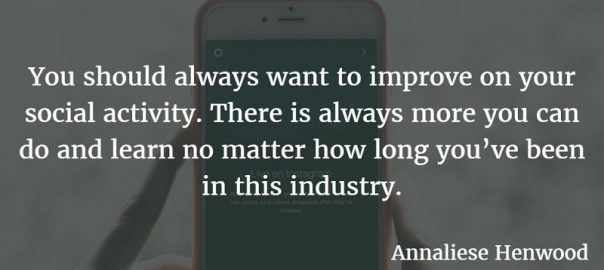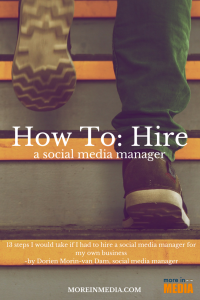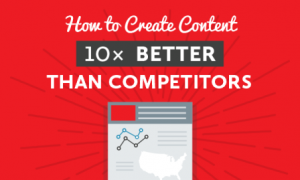The headline of this article asks whether you want to improve your social media marketing. It was a trick question. You should always want to improve on your social activity. There is always more you can do and learn no matter how long you’ve been in this industry.

To assist with your mission to make your social media marketing even better, I’ve included 5 key questions you should ask yourself. This isn’t a one-time thing either. You should ask these questions at least once a quarter because social media isn’t static. It changes rapidly and regularly, so your answers will change with time.
Bookmark this article in your Pocket, Dropmark, or whatever tool you use to keep articles for regular reference. You’ll want to revisit this article every quarter or once a year at least, so keep it safe and accessible.
Now, as for those questions…
— — —
1) Am I active on the right platforms?
Let’s take a moment to consider the different platforms out there and what they’re worth for business marketing.
Twitter is for those businesses that want to have an engaging relationship with their prospects and customers. It’s an important platform for customer service. If you want to be on Twitter, keep in mind that it’s fast-paced and requires real-time engagement to truly bring results.
Now, let’s consider the platform’s key facts and statistics (provided by Hootsuite):
- 317 million people actively use the platform monthly.
- For those of you looking to use Twitter for sales, the platform’s audience includes 30% of Americans with an income above $ 75,000.
- 71% of Twitter users are active on the platform multiple times every day.
- 94% of SMB account followers plan to purchase from them.
- 75% of users have positive opinions of a SMB after reading their tweets.
If you want to offer an engaging, customer service-oriented experience for your leads and customers, you should be on Twitter. Just make sure you’re taking the time to use the platform to its full potential.
Although Facebook pages are losing their organic reach capabilities, there are still reasons why you should be active there. First and foremost, it has the largest audience with over 1.8 billion monthly active users. Yes, you may have to pay for advertisements to reach your audience, but with all the settings and customizations Facebook offers, ads may be worth it.
Even with just organic reach, you have ways to expand on it without paying a cent. It’s all about offering engaging, fun, and valuable content through your page. Share blog content, but also share inside looks into your business. Share memes and live videos. The more variety you offer, the more likely you’ll discover what resonates best with your audience.
Your audience is quickly moving away from text-only updates and more toward images and videos. Instagram has both, and it’s the place to be for image sharing. If you think your business isn’t visual, think again. All businesses can find ways to use Instagram to their advantage. It’s all about creativity:
- Give viewers an inside look at your staff and office
- Share event photos
- Share inspirational quotes and original messages
- Use Instagram advertising
Instagram has a younger audience, but it still offers the opportunity to reach over 600 million active users. If you’re a B2C business, you can’t ignore Instagram. If you’re a B2B business, you should still consider the platform. It’ll just require more strategic thinking to reach the right users.
According to this LinkedIn statistics compilation by Hootsuite:
- 467 million people or brands have chosen to use LinkedIn for professional engagement.
- 94% of B2B marketers use LinkedIn to distribute content.
- 7 of 10 professionals trust LinkedIn for providing professional content.
- 50% of B2B buyers will base their purchase decision on what they find on LinkedIn.
Find more key LinkedIn statistics in this Pulse article by Katy Elle Blake.
Although LinkedIn is certainly more targeted toward B2B and career development, it has a lot to offer any business. Whether you choose to focus on SlideShare or use your leadership to publish long-form content, you have options for making the most of the platform.
Over 150 million people have found a reason to use Pinterest, so have you hopped onboard yet? You might need a little more convincing, so let’s dive into the statistics from last year (compiled by Hootsuite):
- 87% of Pinterest users have bought from a business based on something they found on the platform.
- 93% of users use the site to plan for future purchases.
- Pinterest brings in 5x more offline purchases than any other social platform.
Pinterest is a visual platform you can use to share products, blog content, infographics, and much more. A single pin has a long shelf-life compared to other platforms where your posts get lost almost instantly. It also brings in a good amount of referral traffic to your website.
YouTube
Video is rapidly replacing or limiting text-based content. More and more people are preferring video to text. Have you started using this opportunity to your advantage?
YouTube is a video platform. It’s actually THE video platform with over a billion users watching millions of hours of videos every day. Brands have used the platform to share instructional content in new ways beyond a standard blog post. They also use it to share an inside look at their business operations.
If you want to tap into video marketing, now is the time. Create a YouTube account to engage with your target audience in the way they prefer these days.
Snapchat
With over 150 million daily active users, Snapchat is an ever-growing influence in the social media sphere. Along with that key statistic, Snapchat also tells us their daily users watch over 10 billion videos every day.
Snapchat is for telling your brand story and engaging with your community. Although advertising is pricey, purchasing a Geofilter can get your brand seen by a larger audience.
Whichever social media platforms I did not include still hold their own value. I just focused on the ones that are the most mainstream. If you have input on these platforms or one that wasn’t included, leave a comment to share your thoughts with your fellow marketers.
2) Am I active at the right times?
To be clear: there isn’t a single answer for everyone regarding best times to post on the various social platforms. There’s not a universal strategy. However, you can still learn your own best times through experimentation, research, and strategic thinking.
CoSchedule compiled a few studies on this subject that can help you get started with your timing, but you shouldn’t rely on it as fact for your business. For example, Facebook posting at 1pm on Wednesdays may work for business X, but posting at 5pm on Thursdays may work better for business Y.
The important point to remember is that you need to be active when your target audience is. It shouldn’t be when it’s convenient for you if your audience isn’t there. If need be, schedule some of your content to go out when you can’t publish it manually. Buffer is a handy tool for optimizing your publishing schedule as they give you the times that have worked best for you previously.
3) Am I engaging with my audience in real-time?
If you truly want to get the most out of social media marketing, you need to be there to communicate in real-time. This means engaging 1-on-1 to assist with complaints or show gratitude for praise. It means monitoring chosen keywords for outreach opportunities. You can even use Twitter chats to build authority and develop relationships with other participants.
Do you still doubt the need for real-time engagement? Let’s consider these 5 reasons provided by Snap Agency (altered for this article):
- Your brand’s awareness and image will improve.
- You’ll bring back the “social” in social media.
- Your audience will appreciate being heard.
- Instead of focusing on vanity metrics, you’ll build relationships with real users.
- Your audience will go to you for advice and inspiration as a trusted source for such information.
When looking back at these questions later on, it’s alright to adjust it. Instead of how it is now, why not ask: “How is my real-time engagement performing?” or “Am I engaging with the right audience?” or however you choose to approach it. The focus should be on real-time engagement. The rest of the question is up to you.
4) Do I have an effective customer service strategy?
If your business is on social media, especially Twitter and Facebook, you need to know how to approach customer service on those platforms. With Hootsuite’s customer service tool or Respond by Buffer, you can monitor and respond to complaints before they potentially go viral. Along with complaints, consider responding to praise to build brand advocates for positive word-of-mouth. WOM is one of the strongest marketing tactics in existence, and effective customer service can really help with that.
Do you know exactly why you need to incorporate customer support into your social media strategy? Dive into this article, which goes into great detail about the reasons and methods for social customer support.
If your brand isn’t using social media for real-time, quick customer service, you’re taking a big risk. More consumers are talking about brands on social every day. If they complain to an automated account, they’ll more than likely complain further, which can seriously damage your brand image. Be there when it matters to turn problems into solutions and lost customers into brand advocates.
5) Am I willing to try new things when they appear?
I’ll admit it. I still haven’t hopped onboard the Snapchat train. I understand the difficulty in accepting changes, but it’s important as marketers that we remain adaptable. Social media changes regularly and often. How can you stay up-to-date and social savvy?
First, know your audience and consistently monitor where they’re hanging out. Not only that, know where they’re active. If you notice your engagement rates dying away on Facebook but growing on Twitter, it may be time to ditch the former for the latter. You don’t want to spread yourself too thin, so focus your efforts where you can engage effectively with your audience for a higher return on investment (ROI).
Also, one of the social media features on Facebook and Twitter is trending topics. Too few businesses tap into this deep well of potential. While you want to know exactly how you’ll approach it and when it would be appropriate for your brand, you can see great results from this tactic.
Other ways to monitor trends for engagement opportunities include:
- Create Twitter lists with hashtags or targeted users
- Set up Google Alerts for specific keywords
- Subscribe to influential blogs
You can discover more ways to follow trends via HubSpot’s article on the subject.
The point is: you don’t want to fall behind or be ignored. To be where it matters and act when it counts, you improve your social media marketing. If you are willing to change when it’s time, you’ll stay ahead of the game while your competitors may fall behind.
— — —
What are you going to do now?
These are just 5 questions to keep top of mind with your social media marketing. There are others, but these are key if you want to improve over time. To see growth, answer these questions regularly and make changes when necessary.
How are you improving your social activity, and what would you recommend others do? Leave a comment with your input to help others with their social media marketing. As marketers, it’s important we help each other when we can, so let’s discuss!
Digital & Social Articles on Business 2 Community(11)







